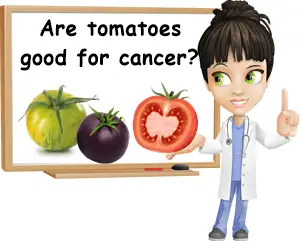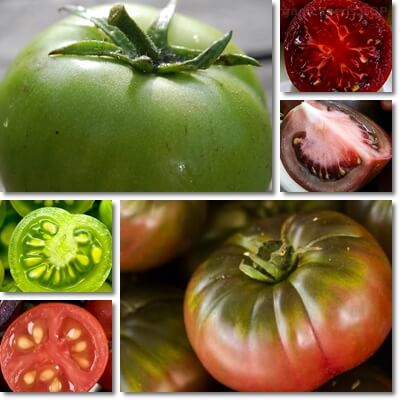When you think about anticancer foods, tomatoes don’t spring to mind first. Or second, or third, or fourth. They aren’t even present on anticancer food lists for that matter.
But did you know that both ripe red, purple and black tomatoes and unripe green tomatoes have scientifically proven anticancer properties?
While this does not absolutely mean tomatoes have active therapeutic effects that could recommend them for the treatment of the disease as they are, it is an indication that including tomatoes in our diet as often as possible can potentially be a source of wonderful health benefits, including some degree of cancer prevention.

Are tomatoes good for cancer?
Studies show both ripe red, purple and black tomatoes and unripe green tomatoes have in vitro and in vivo anticancer properties. That is, tomatoes contain biologically active chemicals that have been shown by research to interfere with tumor growth and spread by disrupting the formation of new blood vessels that feed tumors, inducing normal cell death called apoptosis in cancerous cells and even inhibiting metastasis which is the spread of cancer cells from their original site to other parts of the body via blood vessels or lymphatic vessels.
Tomatoes as anticancer foods
What makes tomatoes anticancer foods is select organic chemicals such as lycopene in ripe tomatoes of the red varieties, anthocyanins in ripe purple and black tomatoes, and tomatine and analogs in unripe, green tomatoes of any variety. These naturally occurring components in tomatoes, lycopene, anthocyanins, and tomatine and analogs, are biologically active, meaning they have an effect on and elicit a response from living tissue.
The nature of this response has been measured by scientific research in both in vitro and in vivo laboratory studies and has resulted in quantifiable anticancer effects. The anticancer activity of tomatoes extends to include several therapeutic aspects, including antioxidant, antiangiogenic, vascular-disrupting, apoptotic and anti-metastatic effects.

Red tomatoes and cancer
The bulk of anticancer properties of ripe red tomatoes is owed to a pigmented antioxidant called lycopene. Lycopene occurs naturally in fresh tomatoes, tomato juice, sauce, paste, concentrate and ketchup, and is more readily taken up by the body from heat-processed tomato products with the addition of fat.
Studies show a higher intake of lycopene resulting in higher circulating levels of the red-pigmented antioxidant is associated with a lower risk of prostate cancer in men. Prospective studies established that frequent consumption of tomatoes and tomato products such as tomato sauce, or lycopene, was persistently associated with a reduced risk of prostate cancer.
While lycopene has been noted as the primary anticancer component in red tomatoes and red tomato products, emerging research by the University Of Illinois At Urbana-Champaign suggests lycopene’s active role in reducing prostate cancer risks is supported and enhanced by other components in the fruit and its byproducts.
Lycopene has also been shown to protect against smoking-induced lung cancer by inhibiting smoke-induced oxidative stress and promoting genome stability (source), extending its potential as an anticancer food.
Ripe purple, blue and black tomatoes and cancer
Purple tomatoes, blue tomatoes and black tomatoes are novelty tomato varieties gaining rapid popularity due to their unusual colors as well as health effects. The tomatoes owe their colors to pigmented antioxidants called anthocyanins. Studies show anthocyanins have in vitro and in vivo anticancer effects against colon, liver, esophagus, skin, breast and leukemic cancer cell lines. More specifically, anthocyanins demonstrate anti-toxic and anti-carcinogenic effects such as:
- directly scavenge reactive oxygen species (ROS)
- increase the oxygen-radical absorbing capacity of cells
- stimulate the expression of Phase II detoxification enzymes
- reduce the formation of oxidative adducts in DNA
- decrease lipid peroxidation
- inhibit mutagenesis by environmental toxins and carcinogens
- antiproliferative action, reducing and inhibiting cell proliferation by blocking various stages of the cell cycle via effects on cell cycle regulator proteins
- selectively inhibit the growth of cancer cells with relatively little or no effect on the growth of normal cells
- anti-inflammatory action, reducing levels of multiple inflammatory markers
Unripe green tomatoes and cancer
Tomatoes are not known as an anticancer food, much less unripe green tomatoes. But unripe green tomatoes are a source of several antioxidant components with anticancer properties, notably chlorophyll and tomatine and analogs.
Chlorophyll is the predominant pigment in green tomatoes responsible for their color. Chlorophyll demonstrates anti-inflammatory benefits, inhibiting inflammatory enzymes COX-1 and COX-2, as well as anticancer activity against breast, colon, stomach, central nervous system, and lung tumor cells, inhibiting tumor growth (source).
Tomatine in green tomatoes is a toxic alkaloid, essentially a poisonous chemical that occurs naturally in the tomato plant, including the stem, leaves and unripe green tomatoes (find out more about what are green tomatoes).
Tomatine is meant to protect the tomato plant from disease and pests, but also demonstrates anticancer properties.
Studies show alpha-tomatine and, to a lesser extent, tomatine analogs from green tomatoes and green tomato extract inhibit the growth of human lung, breast, colon, liver, stomach and prostate cancer cells and metastatic melanoma (source 1, source 2, source 3, source 4). Tomatine in green tomatoes has scientifically verifiable antiangiogenic, vascular-disrupting, apoptotic and anti-metastatic effects that contribute to its anticancer benefits.
